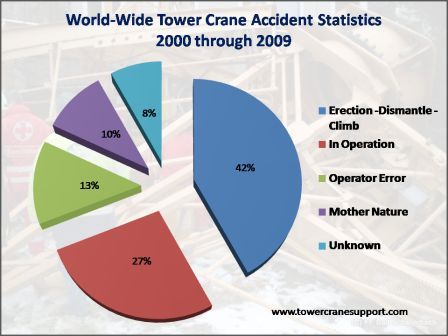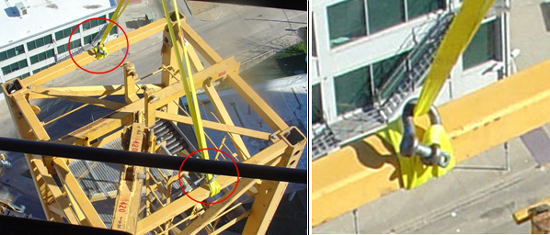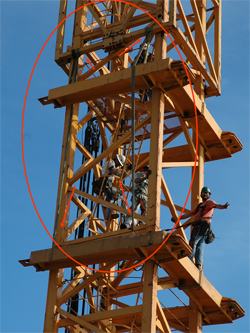
This Article appeared in the September, 09 International Cranes magazine
The recent tower crane collapse incidents in Korea and the UK have once again brought to
our awareness the death and destruction that can be caused by these towering behemoths.
Although these two accidents resulted in the death of one operator and the other seriously
injured, the casualties and property damage could have been much worse.
World-Wide Tower Crane Accident Statistics
2000 through 2009
Since 2000 - 872 Tower Crane Accidents causing over 668 Deaths along with countless
injuries have occured.
Since 2009 there have been over - 116 Accidents, causing 44 Deaths!
As staggering as these numbers are, it may well be double due to the fact that many
incidences are never reported on. This on-going research is the result of countless hours
spent collecting hundreds of reports, pictures and videos to substantiate the findings.
NOTE: These statistics focus specifically on construction related Tower Crane accidents
only. They are for the most part serious incidences causing some kind of death/injury
collapse or damage.

42% = Erection / Dismantle / Climbing
Assemble / Disasemble contributed to 26% and Climbing contributed to 16%. The primary
cause for these failures is; not following manufacturer instructions.
27%
These are in-operation accidents where for a number of reasons; foundation & structural
failures, electrical & mechanical malfunctions were the primary cause.
13%
Not following manufacturer operation instruction. Also, tampering with or knowingly
operating crane with malfunctioning safety limits.
10%
Wind, Earthquakes. Some of the wind related accidents may be due to the Operator not
following proper shut-down procedures.
8%
Due to translation issues and or lack of information, the cause and injuries are unknown.
All too often, close-calls and unsafe practices seem to be the norm when working with
tower cranes.Ask anyone who has been in the field for 30+ years and they would tell you
with a shrug, its the same as it ever was. What makes this puzzling is that tower cranes
are not complicated structures; their basic design, erection and operating principals have
not changed much in decades.You would think that after so many years of executing these
high risk procedures it would be honed down to a science, but this quite often not the
case. So why, with all the hard lessons learned do elementary mistakes continue to plague
the industry no matter the culture.

Rigging was used to hoist mast sections during this climbing operation instead of the
manufactures hook device. Unfortunately improper rigging technique was used, i.e.
both shackles were side-loaded.
Regardless of location; governmental regulators, independent safety organizations and
industry experts have held countless conferences over the past 10 years lobbying to
improve standards. surprisingly the thrust of this attention has been focused primarily
on the operator, mandating them to extensive regulations and responsibilities far beyond
their job title, yet the statistics show operators are only responsible for 13% of accidents.
Incredibly those culpable for the vast majority of tower crane accidents (69%) are held to
much lesser standards. For the most part they are only presumed to be qualified based on
hear-say, rather then documented - specific training, experience and licensing.
For instance here in the U.S. a Hairdressers must complete 1,500 hours of training, be
tested in both written and practical skills, and then be licensed. Yet few if any; erectors,
inspectors and others who work with cranes could comply similarly that which is required
of a Hairdresser!
Manufacturers should also be held accountable. Few offer accessible Erection /
Dismantling and Climbing training, and quite often their manuals regarding these
procedures are unclear and deficient. Its no wonder that those in the field resort to
unsanctioned methods which are prevalent throughout the industry. Another alarming
issue is access to Manufacturer Campaign Bulletins. These manufacturer safety alerts are
currently only distributed to crane vendors, who are reluctant to make known potential
problems with the cranes their trying to sell/rent. In this day and age, manufacturers
should be mandated to allow unrestricted access to these vital crane safety bulletins,
especially to crane inspectors.
Interesting Facts:
The #1 cause of all accidents is simply -- Not following Manufacturer instructions.
In most cases, those responsible for these - 872+ accidents had good reputations and were
regarded as the best!
Over 25% of the deaths and countless injuries are of unsuspecting civilians (many children).
The men that have the dangerous job of cleaning-up these mangled, precarious accident sites
are truly Heroes.

Although a large percentage of these 872+ accidents are concentrated in a few countries, the
same circumstances or events that led to their failures are borderless - - stupid mistakes keep
repeating like a broken record around the world. It seems that in the rush for development,
ones proficiency has been replaced by sub-standards. Terms such as: not ideal situation and
common practice have become acceptable reasoning to disregard engineered instructions.
Gone are the days when one would attend a multi-year apprenticeship to learn a skill, this has
been replaced by fast-food like accreditations or like in most areas, none at all. And to boot,
those of significant authority seldom have the unwavering character to red-tag a situation no
matter what the personal cost.

During this climb down operation, the climber frame was used to lower 2 tie-in collars!
Bottom-line, un-safe acts and/or conditions are the fundamental cause prior to any accident,
and someone had chosen either through ignorance or negligence not to follow a sanctioned
action. These chronic behaviors occur when those who are entrusted to execute these high risk
operations are under trained, pressured and left unsupervised. Craning is high risk business and
accidents will never be totally eliminated, there are just too many variables. However, the
senseless, avoidable accidents can most certainly be minimized by following some meaningful
standards:
1). Public safety is paramount.
2). Strict adherence to Manufacturer instructions.
3). Qualifications - Everyone should be thoroughly trained and experienced with the task at hand.
4). Prudent planning - Beware; once a schedule falls behind, short-cuts are inevitable.
5). Dismantling - Assist crane should not exceed 75% capacity
6). Independent oversight - The last-line of defense is on-site audit during high risk procedures.
Too many times, we have seen the devastating results that a worst-case scenario can bring. It is
my belief that lives can be saved, property damage averted and reputations preserved through
meaningful regulationsstrictly enforced.
Terry McGettigan is a veteran in the crane industry with 50 years experience.
Presently working as a Crane Accident Investigator
Http://towercranesupport.com